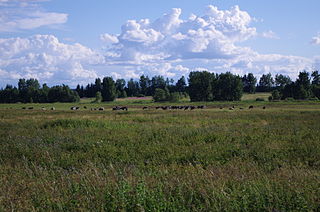| |||||
| Decades: | |||||
|---|---|---|---|---|---|
| See also: | |||||
This article lists events that occurred during 1987 in Estonia .
| |||||
| Decades: | |||||
|---|---|---|---|---|---|
| See also: | |||||
This article lists events that occurred during 1987 in Estonia .
| | This section is empty. You can help by adding to it. (December 2020) |
| | This section is empty. You can help by adding to it. (December 2020) |

Tallinn is the capital and most populous city of Estonia. Situated on a bay in north Estonia, on the shore of the Gulf of Finland of the Baltic Sea, Tallinn has a population of about 454,000 and administratively lies in the Harju maakond (county). Tallinn is the main financial, industrial, and cultural centre of Estonia. It is located 187 km (116 mi) northwest of the country's second largest city, Tartu, however only 80 km (50 mi) south of Helsinki, Finland, also 320 km (200 mi) west of Saint Petersburg, Russia, 300 km (190 mi) north of Riga, Latvia, and 380 km (240 mi) east of Stockholm, Sweden. From the 13th century until the first half of the 20th century, Tallinn was known in most of the world by variants of its other historical name Reval.

Tartu is the second largest city in Estonia after Tallinn. Tartu has a population of 97,435. It is 186 kilometres southeast of Tallinn and 245 kilometres northeast of Riga, Latvia. Tartu lies on the Emajõgi river, which connects the two largest lakes in Estonia, Lake Võrtsjärv and Lake Peipus. From the 13th century until the end of the 19th century, Tartu was known in most of the world by variants of its historical name Dorpat.

The Singing Revolution was a series of events in 1987–1991 that led to the restoration of independence of the three then Soviet-occupied Baltic countries of Estonia, Latvia, and Lithuania at the end of the Cold War. The term was coined by an Estonian activist and artist, Heinz Valk, in an article published a week after the 10–11 June 1988 spontaneous mass evening singing demonstrations at the Tallinn Song Festival Grounds.

Tartu County is one of 15 counties of Estonia.

The MS Estonia was a cruiseferry built in 1980 for the Finnish company Rederi Ab Sally by Meyer Werft, in Papenburg, West Germany. She was employed on ferry routes between Finland and Sweden by various companies until 1993, when she was sold to Nordström & Thulin for use on Estline's Tallinn–Stockholm route. The ship's sinking on 28 September 1994, in the Baltic Sea between Sweden, Finland and Estonia, was one of the worst peacetime maritime disasters of the 20th century, claiming 852 lives.

Erika Salumäe is an Estonian track bicycle racer who won the first Olympic gold medal for Estonia after the country regained independence in 1991.

Chud or Chude is a term historically applied in the early East Slavic annals to several Finnic peoples in the area of what is now Estonia, Karelia and Northwestern Russia.

Kambja is a small borough in Tartu County, Estonia. It is the administrative centre of Kambja Parish.

Elva is a town in Elva Parish, Tartu County, Estonia.

Kärdla Airport is an airport in Estonia. The airport is situated 7 nautical miles east of the town of Kärdla on Hiiumaa island.

JK Narva Trans, commonly known as Narva Trans or just Trans, are a professional Estonian association football club based in Narva that compete in the Meistriliiga, the top flight of Estonian football. The club's home ground is Narva Kreenholm Stadium.

Baltic German nobility was a privileged social class in the territories of today's Estonia and Latvia. It existed continuously since the Northern Crusades and the medieval foundation of Terra Mariana. Most of the nobility were Baltic Germans, but with the changing political landscape over the centuries, Polish, Swedish and Russian families also became part of the nobility, just as Baltic German families re-settled in locations such as the Swedish and Russian Empires. The nobility of Lithuania is for historical, social and ethnic reasons separated from the German-dominated nobility of Estonia and Latvia.

Estonian History Museum is a museum about the history of Estonia in Tallinn. It was initially established by pharmacist Dr. Johann Burchart who ran the town hall pharmacy known as the Raeapteek.

Vändra is a borough in Põhja-Pärnumaa Parish in Pärnu County, Estonia. It has a population of 2,191 and an area of 3.28 km².
The Korvpalli Meistriliiga (KML), known as the PAF Korvpalli Meistriliiga for sponsorship reasons, is the top-tier basketball league in Estonia. The league is organized by the Estonian Basketball Association.

Anna is a feminine given name, the Latin form of the Greek: Ἄννα and the Hebrew name Hannah, meaning "favour" or "grace" or "beautiful".

Estonia, formally the Republic of Estonia, is a country by the Baltic Sea in Northern Europe. It is bordered to the north by the Gulf of Finland across from Finland, to the west by the sea across from Sweden, to the south by Latvia, and to the east by Lake Peipus and Russia. The territory of Estonia consists of the mainland, the larger islands of Saaremaa and Hiiumaa, and over 2,200 other islands and islets on the eastern coast of the Baltic Sea, covering a total area of 45,339 square kilometres (17,505 sq mi). The capital city Tallinn and Tartu are the two largest urban areas of the country. The Estonian language is the indigenous and the official language of Estonia; it is the first language of the majority of its population, as well as the world's second most spoken Finnic language.
1987 in television may refer to:

Pirgu is a village in Rapla Parish, Rapla County in northwestern Estonia. Between 1991–2017 the village was located in Juuru Parish.

Martin Järveoja is an Estonian rally co-driver. He is currently teamed with Ott Tänak and is competing for M-Sport in the World Rally Championship.